 |

 |
 |
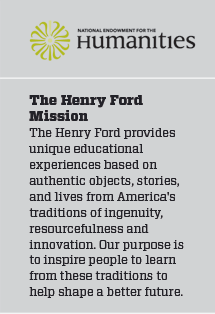 |
The America’s Industrial Revolution Teacher Workshops at The Henry Ford will draw together selected NEH Summer Scholars with leading humanities guest scholars and museum host scholars for unique enrichment exercises centered on the impact of industrialization. The workshops are designed to encourage your curiosity and deepen your knowledge on the subject, engage you with innovative methods of transmitting enthusiasm and content to students, and empower you to use cultural resources to enliven the teaching and learning of history. The Henry Ford in its entirety presents an exemplary living case study of American Industrialization and showcases through its sites and artifacts how the country morphed from a fledgling nation built around agriculture to one that was defined by its cities, its machines, and its manufacturing.
NEH Summer Scholars will explore the diverse ways that Americans experienced social change between the 1760s and the 1920s through lecture/discussions and by visiting with museum curators at 12 of the 80 historic sites interpreted in Greenfield Village: Thomas Edison’s Menlo Park Laboratory, Hermitage Plantation Slave Quarters, 1760s Daggett Farm, 1880s Firestone Farm, a railroad roundhouse, and a 19th century grist mill for instance. In addition, time is set aside each day for exploration of archival sources in the Benson Ford Research Center and to work on individual lesson plans for implementation back home.
The week’s activities will culminate with a visit to a related National Historic Landmark, the Ford Motor Company’s Rouge Industrial Complex. Taken as a collective entity, there is no better landmark site in this nation to study the range and diversity of America’s rise to industrial dominance. Reliable scholarship, energetic scholars and the resources of the museum will make this workshop thematically rich. Your questions and contributions as classroom teachers will make it educationally powerful.
Five specific themes comprising the essence of industrialization were developed from scholarly research and discussions with our visiting scholars and teacher partners. After a Sunday evening orientation, each day of the workshop is organized topically in rough chronological sequence and will focus on a theme explored in a ‘Guiding Question.’ Each day’s Guiding Question focuses on interactions between technological and organizational changes and work, race, gender, social status, and economic condition. The visiting scholars, all of whom have had works published on these topics and have participated in similar teacher education programs, suggested the readings related to these themes. Daily themes will be as follows:
Monday: The Transition From Home to Factory Production- The Day’s Guiding Questions: How did family life and gender interact with the shift from home to factory production? How did entrepreneurs integrate family and gender roles with new technologies and work patterns? How can artifacts help us understand this process?
- Visiting Scholar: Nancy Gabin, Associate Professor of History, Purdue University
- Host Curator: Jeanine Head Miller, Curator of Domestic Life, The Henry Ford
- Overview: Professor Gabin will share her scholarship and insights about the role of families, gender roles and relations, and class and status in 19th century America and how there was a new separation of spheres with home becoming the woman’s place and work becoming the man’s place. Women’s work inside the home was mostly unpaid and often unappreciated which forced some women to find work in factories for wages and some independence.
- The Day’s Guiding Questions: What was the impact of immigrant groups as well as soil and climate on farming systems? How did mechanization of agriculture contribute to distinctly different regional and sectional agricultural systems? What influence did this have on practice and ideology, especially slavery?
- Visiting Scholar: R. Douglas Hurt, Chair, History Department, Purdue University
- Host Curator: Ryan Spencer, Manager, Firestone Farms, The Henry Ford
- Overview: Professor Douglas Hurt’s morning lecture will offer a detailed look into the development of farm equipment during the Industrial Revolution with case studies of plows, flails and reapers. More efficient tools and machines, while more expensive on the front-end, lead to the need for fewer laborers thus saving the farmer time and money. The development of new tools also led to changes in the size of farms and amount of produce raised.
- The Day’s Guiding Questions: How did the development of steam power in transportation affect daily life and manufacturing activity? How did railroads affect patterns of consumption?
- Visiting Scholar: Martin Hershock, Associate Provost for Academic Affairs and Graduate Programs and Professor of History, University of Michigan-Dearborn
- Host Curator: Matt Anderson, John and Horace Dodge Curator of Transportation, The Henry Ford
- Overview: Professor Hershock will provide a detailed account of the rise of steam engines, particularly focusing on the American railroad, and the social changes that occurred as a result. Cities and states were more connected and some felt the country was less open and available for pioneering. New technology posed risks for laborers, especially child laborers, like dangerous work situations and poor housing conditions.
- The Day’s Guiding Questions: How did the application of scientific theory and technological innovation in the late 19th century affect the scope and scale of technological and social change? Why has corporate R & D become so important to business success over the past 150 years?
- Visiting Scholar: Paul Israel, Professor, Rutgers University, and Editor-in-Chief of the Edison Papers.
- Host Curator: Marc Greuther, Chief Curator and Curator of Industry and Design, The Henry Ford
- Overview: Dr. Israel will talk about how the corporate research laboratory of today has given us the greatest invention of modern times, the knowledge of how to invent. As an example, it was not only Edison’s inventions, but the way he invented with a team of experts at a research facility, that changed the way the United States funds and facilitates innovation. This lecture details the life of Thomas Edison, his inspirations, his patents, his inventions and his legacy. Dr. Israel will also refer to other 19th century inventors such as Alexander Graham Bell, Nikola Tesla, George Westinghouse, Charles Steinmetz and others.
- The Day’s Guiding Questions: Why did the automobile industry pioneer assembly line production techniques and what was the impact on urban life, particularly for immigrants? Why is assembly line mass production suitable for some products and not others?
- Visiting Scholar: Robert H. Casey, Retired John and Horace Dodge Curator of Transportation
- Host Curator: Matt Anderson, John and Horace Dodge Curator of Transportation, The Henry Ford
- Overview: Scholar Bob Casey will provide a comprehensive overview of the Ford Motor Company and the early automobile industry’s role in changing the manufacturing process and its impact on urban life. The presentation will also discuss Ford Motor Company’s labor management techniques, including the “Five Dollar Day,” and the impact they had on society.
As a discrete topic, the American Industrial Revolution can be summarized as the story of American society evolving from a colonial outpost on the periphery of the world’s dominant imperial system to the world’s largest industrial producer. This has been a topic of significant innovative scholarship over the past generation. Scholars continue to debate the relationship between business organization and technological innovation, economic change and social class formation, and the impact of industrial transformation on the physical and social landscape of America.
The topic of the American Industrial Revolution is a very complex one, yet it is often portrayed in textbooks as a post-Civil War phenomenon, with only brief attention given to the inventions of Eli Whitney, Robert Fulton, Samuel Colt, and Elias Howe, as well as the antebellum organization of New England textile factories. A venerable Advanced Placement text (Thomas A. Bailey, updated by David M. Kennedy and Lizabeth Cohen, The American Pageant, Houghton Mifflin, 2002) skims over these topics but devotes an entire section to “Forging an Industrial Society, 1865-1899.” Changes in agriculture, transportation, communication and manufacturing are placed in the context of business, urban and political history as well as social history. The high school text used in the Detroit Public Schools sums it up this way, “From 1865 to 1910 the United States experienced a surge of industrial growth” (Paul Boyer and Sterling Stuckey, The American Nation, Holt, Rinehart and Winston, 1995). Using The Henry Ford’s resources, this workshop will expand this chronology, connecting pre-Civil War changes in family farming, transportation and urban crafts to later industrial developments. This topic is ripe for historic site, material culture, and living history interpretations—educational opportunities that exist in every part of the country and in which The Henry Ford excels. We want to bring professionals together to develop materials and methods to engage students more actively and authentically in examining America’s Industrial Revolution.
In sum, participants in this program will have the opportunity to see, hear, smell, taste, and touch, as well as read and discuss, America’s Industrial Revolution.
NEH Summer Scholars attending the workshop will be expected to complete all of the assigned readings and actively participate in all lectures, discussions and field experiences. Each reading successfully supplements the content in the NEH Summer Scholars’ presentations and provides additional context for site visits, so that participants gain a greater understanding of the social context in which content is being presented. Ruth Schwartz Cowan’s More Work for Mother, for example, describes how the role of women’s work changed and gives specific examples that NEH Summer Scholars can specifically look for during their site visits, while Douglas Hurt’s Agriculture: A Brief History gives background knowledge on the role of agriculture during the different stages of American history, which allows him to dive deeper during his presentation on Day 3. Readings and other materials will be sent to NEH Summer Scholars before the workshop itself. The Henry Ford expects that all NEH Summer Scholars complete the assigned readings prior to the start of the workshop to ensure great dialogue and discussion. For a list of the required readings, click here. NEH Summer Scholars will develop and share age-appropriate lesson ideas. Materials and lesson plans will be posted to The Henry Ford’s Education website so that we can continue to share ideas and materials after the workshop. We also encourage NEH Summer Scholars to submit their lesson plans to NEH’s EDSITEment website. EDSITEment offers a treasure trove for teachers, students, and parents searching for high-quality material on the Internet in the subject areas of literature and language arts, foreign languages, art and culture, and history and social studies.
The Daily Schedule* |
|
| 8:30am-9am | Introduction to the day’s activities |
| 9am-10:30am | Guest scholar’s lecture and discussion |
| 10:30am-10:45am | Morning break |
| 10:45am-3pm | Exploring sites in Greenfield Village; Lunch |
| 3-3:30pm | Afternoon Break |
| 3:30-5pm | Curriculum development activities |
| 5-6pm | Sharing projects and wrapping-up the day |
*tentative/subject to change |
|
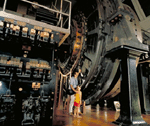 |
Made in America in Henry Ford Museum is an exhibit that explores the legacy of American innovators from the 18th to 20th century who made America a manufacturing superpower. We will begin our week-long study of America’s Industrial Revolution with a guided tour of the exhibit’s artifacts, which include operating steam engines. |
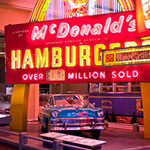 |
Driving America in Henry Ford Museum is an exhibit that shows how a product of the Industrial Revolution, the automobile, led us to reshape our culture and landscape, with both positive and negative consequences. Throughout the exhibit, the consumer’s role in the innovation process is emphasized, empowering visitors to realize how our automotive decisions defined our past and will define our future. |
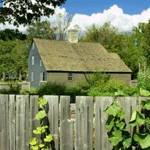 |
The Daggett Farm House (ca 1760) in Greenfield Village is a typical middle-class colonial American farmstead. By 1772, the farm consisted of 160 acres of land. The Daggetts practiced a modified form of subsistence agriculture. Rather than growing a cash crop for market, they raised a wide variety of crops for home consumption. If the Daggetts had a surplus of goods they could engage in barter or trade among their neighbors. This site helps us understand life prior to widespread industrialization in the Americas. |
 |
Loranger Gristmill (1837-1925) in Greenfield Village was powered by a waterwheel and represents an important link between agriculture and mechanization. Farmers relied upon mills such as this one to convert their crops (particularly corn and wheat) into useful products that could be consumed or sold. As technology changed, so too did the gristmill. With the development of better transportation networks, milling became less and less localized. Wheat could be shipped greater distances for processing. |
 |
Tripp Up-and-Down Sawmill (ca 1855) in Greenfield Village was built in Tipton, Michigan and represents the development of lumber sawing from a slow, hand process to a high-speed, mechanized industry. The sawmill’s engine drives the blade at 120 strokes a minute and can cut a sixteen-foot log in twelve minutes. Later circular saws could do the same work in fifteen seconds! |
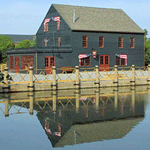 |
Weaving Shop in Greenfield Village was built in the second quarter of the 19th century in Bryan County, Georgia. As it stood on its original site, most of the first floor of the Weaving Shop was open, allowing access for horses to the drive mechanism for a cotton gin located on the upper floors, which were enclosed. When it was initially rebuilt in Greenfield Village the first floor remained open, but by 1944 the entire first floor had been enclosed and a one-story well had been added. |
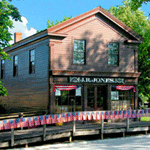 |
J.R. Jones General Store (ca 1880) in Greenfield Village was ran by J.R. Jones and sold products such as coffee, sugar, fabric and shoes. The second floor had a variety of uses over the years – including a roller skating rink, a place to see shows and the living quarters for the Joneses. When Henry Ford put this store in Greenfield Village, he asked J.R. Jones to visit the store on its new site. |
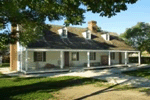 |
Susquehanna Plantation (ca 1860) in Greenfield Village was a 700-acre Maryland agricultural plantation worth $118,000 in 1860. Susquehanna Plantation cultivated about 60 acres of tobacco in 1860. As tobacco cultivation was a very labor-intensive process, the Carroll family relied on enslaved people to make a profit. A dependence on labor prevented the Carroll family from investing in new technologies. |
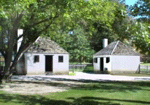 |
Hermitage Slave Quarters (ca 1850) in Greenfield Village existed on the Hermitage Plantation near Savannah, Georgia. This plantation consisted of 400-600 acres and housed 201 enslaved people in 52 buildings. As an industrial plantation, Hermitage relied on a system of enslaved labor very different from those at primarily agricultural plantations. |
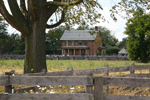 |
Firestone Farm (ca 1885) in Greenfield Village was a typical Midwestern farmstead of the 1880s when mechanization and the marketplace were rapidly changing farming. Farmers were drawn into the commercial economy. Between 1850 and 1870, the United States experienced what historian Wayne Rasmussen calls the “first American agricultural revolution.” The 1880s Firestone Farm certainly reflects this shift in technology. |
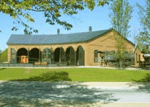 |
DT&M Roundhouse (ca 1884) in Greenfield Village is an engine house built exclusively to repair and maintain steam-powered locomotives. Steam trains require a lot of maintenance, and thus roundhouses were crucial in keeping railroads operating efficiently and profitably. They were built by railroad companies all over the United States wherever their engines would need to be maintained or repaired. |
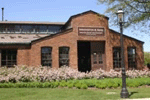 |
Armington and Sims Machine Shop and Foundry (ca 1882) in Greenfield Village is typical of steam-driven machine shops in the late nineteenth century. It was a general-purpose job shop, which produced a variety of engines, machines and machine parts rather than focusing on the high-volume production of a small number of products. Such machine shops were key components of American manufacturing in the19th century. |
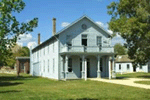 |
Menlo Park Laboratory (ca 1876) in Greenfield Village was built by Thomas Alva Edison in 1876 in order to pursue his career as a fulltime inventor of electromechanical instruments. Recognizing that he could not be successful working entirely on his own, Edison assembled a team of men—including scientists, craftsmen, machinists, mathematicians, and other assistants—to work with him at Menlo Park. Edison earned almost 400 patents in six years including the electric lighting system. Menlo Park marks the origins of modern technological research and development. |
 |
Charles Steinmetz Cabin (ca 1890s) in Greenfield Village is a sparsely-furnished, rudimentary wooden structure used as a rural retreat by renowned electrical engineer Charles Proteus Steinmetz (1865-1923). Steinmetz’ electrical formulas enabled the electrical systems seeded by Edison to grow into long distance transmission networks. |
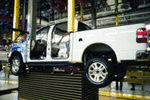 |
Ford Rouge Factory (1917-Present) was the largest and most famous industrial site in the world by 1930. Henry Ford created a virtually self-sufficient manufacturing process in which he owned and operated every aspect of production from the raw materials to the finished automobiles. The Rouge became the symbol of American industrial might and was emulated by industrialists worldwide. It is currently where new Ford F-150s are built. |
Note: While all daily site visits are on The Henry Ford’s campus, summer scholars will have to walk outdoors to the respective sites. Motorized scooters are available, in a limited capacity, upon request. Because the workshops take place in the summer, please plan for warm temperatures.
Copyright © 2013 20900 Oakwood Blvd., Dearborn, MI Call Center: 313.982.6001 or 800.835.5237 The Henry Ford is an independent, non-profit, educational institution not affiliated with the Ford Motor Company or the Ford Foundation. The Henry Ford is an AAM accredited institution. |